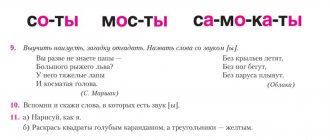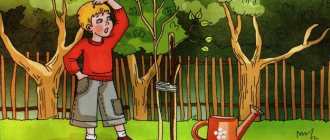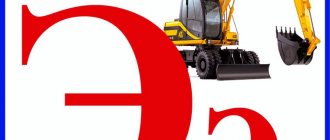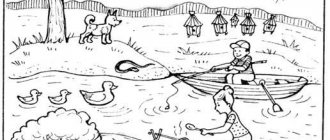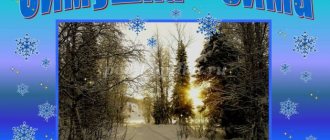Introducing the letter Y
It is easiest to explain to a child what this letter looks like using pictures . A visual sequence is created from the words: tea, iodine, parrot, yogurt, yogi. All words are spoken loudly with the children. You need to pay attention to the overall sound through intonation. The guys must guess whether Y is located at the beginning or at the end of the word.
The next stage is a separate pronunciation of Y. At the same time, the teacher explains how the speech apparatus should work: the tip of the tongue is hidden behind the lower teeth, and the back of the tongue rises up and does not allow air to escape from the mouth.
What children should know about the sound Y:
- is it vowel or consonant;
- voiced or voiceless;
- long or short.
Looking at the image of Y, the children guess what other letter it is similar to and find out how they differ:
- Look, I and Y are almost the same, but the sounds are different: I is a vowel, and Y is a consonant.
The material is reinforced with new examples: seagull, Aibolit, tram, beautiful, bunny, kind, hero, red. Words are sorted by syllables.
Poems about the letter J for children
Masha loves yoghurt very much, yoghurt is not porridge.
ATTENTION!
REGISTER FOR COURSES! RECRUITING! More details on the page: https://academy.multi-mama.ru/product/multi-predlozhenie/
I. Ditkovskaya
***
The letter Y cries so bitterly: - Oh, what a biting iodine!
I. Krasnikova
***
And not in a cap, and not in a hat. The letter Y is walking around in a hat! Why is she wearing a hat? Because it’s more fashionable this way!
N. Manzhos
***
Yoga is exercise, We need iodine for treatment, Children love yogurt, Yemen is Asia, it’s hot.
A. Beshentsev
***
Yogurt is delicious with blackberries, cherries, melon and strawberries. Only my most favorite pink yogurt with raspberries.
D. Smiles
Do you like poems about the letter Y?
Do you want poems about all the letters of the Russian alphabet to always be at your fingertips?
So that you can reinforce the material with your child?
Check out our Mini-Book “Poems about the Alphabet”
It is made in .pdf format, it contains bright pictures from articles on our site in good quality.
Setting the sound Y
Before starting the exercises, it is necessary to correctly establish articulation: arch the tongue so that its tip rests with tension on the lower teeth. The upper part, in contact with the sky, should also be hard. The child will feel a compressed stream of air when pronouncing the sound Y. Then you need to ease the tension of the tongue and remove the arch.
To make the activity fun, ask the children to show how the cat gets angry and arches its back using its tongue.
Several more articulation training sessions contribute to correct speech production.
- Spatula. Open your mouth, exposing your teeth, place a tense tongue in the form of a spatula on the lower row of teeth so that the edges of the tongue touch the corners of the mouth.
- Smile. Smile several times with your lips closed and open.
- Let's punish the naughty tongue. Place your tongue on your lower lip and lightly bite it with your upper teeth with the sound “ta-ta-ta,” then slap your lips with the sound “five-five-five.”
Basic methods
In addition to directly pronouncing the sound Y, there are two auxiliary methods:
- Imitation:
- rapid pronunciation of the sound I with A, O, U followed by yotation (ia-ya, io-yo, iu-yu);
- transition from soft unvoiced to voiced.
- Mechanical impact. Apply with a spatula in difficult cases. When pronouncing the sound “zya,” the speech therapist presses on the tip of the tongue and moves it slightly deeper until the sound “ya” is produced.
Task for preschoolers: printed letter Y
After a visual demonstration, you can begin to study the letter on paper . Before this, children will happily repeat after an adult how to write Y in the air, and then try to perform the action with a simple pencil or pen.
Copying the printed letter y.
For convenience, it is better to use a checkered notebook sheet. You need to start with the elements: first show how to draw two vertical lines, then a diagonal line and an upper bow. When the child completes these tasks, he will easily cope with the entire letter. If difficulties arise, ask him to draw lines along the reference points or dotted lines.
Children are just beginning to learn the alphabet, so don't insist on spelling.
Tales about the letter
Preschool children perceive many concepts and phenomena through fairy tales. Letters and sounds are no exception; they play different fairy-tale roles and themselves become bright and memorable characters.
A fairy tale about a mouse - yoga.
One day a mouse was walking in the garden and found a book there. “Who are yogis,” he read, and then looked at his uncle on the cover. He sat down with his eyes closed on a board covered with sharp nails. The mouse opened the book and saw the same guy standing on hot coals and sitting in a block of ice.
“Oh yes yogi!” - exclaimed the mouse. - “I want to try this too. I can imagine how surprised my mother will be when she sees me in the refrigerator!”
The animal decided to start with nails, but as soon as it tried to lie down on a prickly board, it shouted to the whole garden: “Oh, Oeeeeee!”
The mouse ran home, found iodine and began to smear it on his scratches. And iodine burns. The mouse oohed and oohed, and then thought: “I’ll throw this book to the cat, let him be a yogi now!”
A fairy tale about sisters I and J.
One day I and J went to a cafe after a walk. The waiter approached them and asked:
— What will you order?
The letter Y answered clearly and quickly:
- Please, seaweed salad - there is a lot of iodine, tea and puff pastry with cherries. All.
I started ordering here:
- And I want carrot salad with raisins and cabbage salad, and Olivier salad, and... and...
Poor And could not stop and kept talking and saying:
- And ice cream sundae, and with jam, and with condensed milk, and with strawberries...
The waiter stopped writing down and looked at I in surprise. Then sister Y guessed, took off her hat and put it on I, she became short and was able to stop.
For a long time they ate everything that was brought to them. Since then, Yi has not gone to a cafe alone, because only her sister Y can separate everything (may-ka, layer-ka) and complete it, so she can more often be found at the end of a word - give, bark, than at the beginning - iodine, yogurt .
Poems about the letter Y for 1st grade
Iodine is good, iodine is not evil. In vain you shout: “Oh-oh-oh!” — I just saw a bottle of iodine. Iodine sometimes burns, of course, but a wound smeared with iodine will heal faster.
V. Lunin
***
A yogi will never say: “Oh!” "Oh oh oh!" - the yogi will not shout. Young man, control yourself! Old, be like young!
V. Berestov
***
We smear iodine on our knees, different bobs,
Mashkin's and Lenkin's noses and legs.
I. Goryunova
Suitable games for children
Namely:
- We learn letters and clap our hands: clap once when the sound Y appears: fox, name, husky, toffee, car, wash, strength, parrot, crocodile, husky.
- My, my, mine: my sparrow - my sparrows, my tram - my trams, my nightingale - my nightingales, my T-shirt - my T-shirts.
- Ask to do something depending on the verb: sing - sing, play - play, dance - dance, etc.
In a playful way, it is easier for children to master the pronunciation of complex sounds and remember the rules for their use.
Goal: development of reading skills, development of phonemic hearing, development of memory and attention, development of motor functions. Coding development. Formation of the ability to determine the location of sound in a word, development of grapho-motor functions.
Materials : worksheet, simple and colored pencils, counting sticks and buttons.
Lesson plan.
1. Introduction to the topic. 2. Development of the articulatory apparatus. Pure talk. 3. Fixing the image of the letter. Letter Y. 4. Development of phonemic hearing. A game. Guess the sound. 5. Outdoor game. Days of the week. 6. Learning to read. Words. 7. Work on proposals. Proposal scheme. 8. Development of phonemic hearing. Repeat a series of syllables. 9. Massage break. Cones. 10. Development of attention. Find the words. 11. Lexico-grammatical structure of speech. Offers. 12. Dictation. Offers. 13. Finger gymnastics. Spider. 14. Preparing your hand for writing. Fly agarics. 15. Summary.
Progress of the lesson.
“What does the letter “Y” look like?
Development of the articulatory apparatus. Pure talk. The teacher invites the children to repeat after him the pure sayings in a whisper and slowly. And then - loud and fast.
La-la-la - milk... (drank). Li-li-li - berries from the forest... (brought). Mo-mo-mo - let's eat... (popsicle). Ri-ri-ri - on the branches... (bullfinches). Ay-ay-ay - here comes the month... (May).
Fixing the image of the letter. Letter Y.
The teacher shows a card with the letter Y. - What letter is this, name it. — What sound does the letter Y represent? Remember the characteristics of the sound Y. - That's right, the sound Y is consonant, sonorous and always soft. - Let's make it out of sticks, so as not to forget the letter Y. Children make the letter Y from counting sticks, and make a hat for the letter from a button. —
Trace the letters Y on the worksheets.
Development of phonemic hearing. A game. Guess the sound.
- I pronounce the words. If you hear the sound y in a word, you clap your hands; if there is no sound y in the word, you don’t clap your hands. Words: may, give, house, bark, snow, light, iodine, blow, poppy, yogurt.
Outdoor game. Days of the week.
Children stand in a circle. On Monday I swam (pretend swimming) And on Tuesday I painted. (Pretend to draw.) On Wednesday I took a long time to wash my face, (we wash my face.) And on Thursday I played football. (Running in place.) On Friday I jumped, ran, (jumped.) Danced for a very long time. (We spin around in place.) And on Saturday, Sunday (claps hands.) I rested the whole day. (Children squat down with their hands under their cheeks and fall asleep.)
Learning to read. Words.
We invite children to read the syllables first on the worksheet line by line, and then in columns. - Read the syllables in a whisper, and then quickly. - Find and underline the words among the syllables. (HOWL, BARK, PARADISE, ROAR, FIGHT, SING).
Working on proposals. Proposal scheme.
- Read the sentence on the worksheet.
- Say the first word. Second. Third.
- Outline your proposal.
- What did Ira draw? (Drawing). What drawing? (Beautiful).
- Think about what kind of picture Anya drew and make up a story.
- Divide the word: DRAWN into syllables.
- Name the stressed syllable in this word. Place emphasis.
Development of phonemic hearing. Repeat a series of syllables.
The teacher and children sit on the carpet in a circle. The teacher pronounces a few syllables and throws the ball to one of the children. The child catches the ball, exactly repeats the sequence of syllables after the adult and throws the ball back. The teacher pronounces a new chain of syllables and throws the ball to another child.
All children take part in the game.
Chains of syllables: ah – oh; ouch - ouch - ouch; y - y - oh; hey - hey - hey; ouch - ouch - ouch - ouch.
Massage break. Cones.
The squirrel collected cones (we transfer the cone from one hand to the other), for the raccoon and for the mouse. One, two, three, four, five (we squeeze the cone with our palms for each count), I’ll find the cone again (we roll the cone between our palms). Three for the raccoon and three for the mouse (we squeeze the pine cone with one hand, then with the other), the rest for whom are the cones (we roll the pine cone between our palms)?
Development of attention. Find the words.
The teacher draws the children’s attention to the fourth task on the worksheet.
- Look what beautiful beads you can make from letters!
- Words were hidden in the beads. Read all the words you see.
- Color each word in any color.
- Let's remember what vowel sounds we know.
- Color the vowel circles red.
Lexico-grammatical structure of speech. Offers.
- Look at the picture, name the objects that are drawn on it.
- Color the objects that have the sound Y in their names (APPLES, COOKIES, EGGS).
- Make sentences based on the diagrams based on the picture.
Dictation. Offers.
The teacher dictates words to the children syllable by syllable.
— Mac grew up. End of sentence. What did you put at the end of the sentence (Period). What letter did you use to spell the word Mac? (Capitalized). Why? (Since this is the beginning of a sentence).
- Ira na-li-la juice. End of sentence. Underline the word in the second sentence that has three syllables.
Finger gymnastics. Spider.
Once upon a time there lived a little spider (hands together, thumbs touching). A spider ran and ran across the grass (we move our fingers on the table), Saw a large flower and climbed onto it (raise our arms up). And the flower swayed from side to side (wrists together, fingers spread, sway). Suddenly a cloud appeared in the sky (we make an oval with our hands). It began to rain heavily (we tap our fingers on the table). And the flower closed its petals (we lean our palms against each other). A strong storm has begun (we strongly swing the arms from side to side). But the sun appeared in the sky (we place one palm on top of the other with fingers spread) and drove away the cloud (we make a sharp movement to the right). The spider got out (we move our fingers and lower our hands down) and ran away (we hide our hands under the table).
Preparing your hand for writing. Fly agarics.
— Circle the fly agarics, trying not to take your hands off the sheet of paper. - Draw dots on the mushroom caps.
Summarizing.
